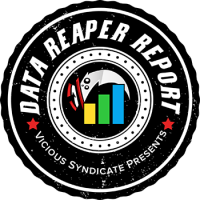
Welcome to the 57th edition of the Data Reaper Report!
Our Data Reaper Project, including the Data Reaper Live (Beta) has 2,200 active contributors. Without them, this project would not be possible, so we’d like to thank all of our contributors for their help.
Quick Links
Class/Archetype Distribution | Class Frequency | Matchup Winrates | vS Power Rankings | Class Analysis & Decklists | Meta Breaker of the Week | How to Contribute | Credits
Number of Games
| Overall | 50,000 |
| Legend | 6,000 |
| Ranks 1-5 | 18,000 |
| Ranks 6-10 | 12,000 |
| Ranks 11-15 | 7,000 |
Class/Archetype Distribution
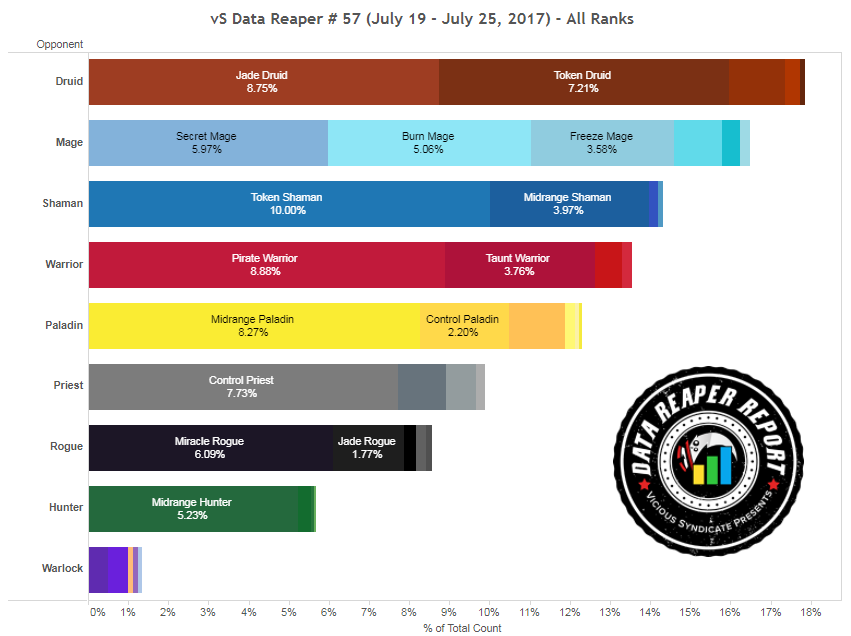
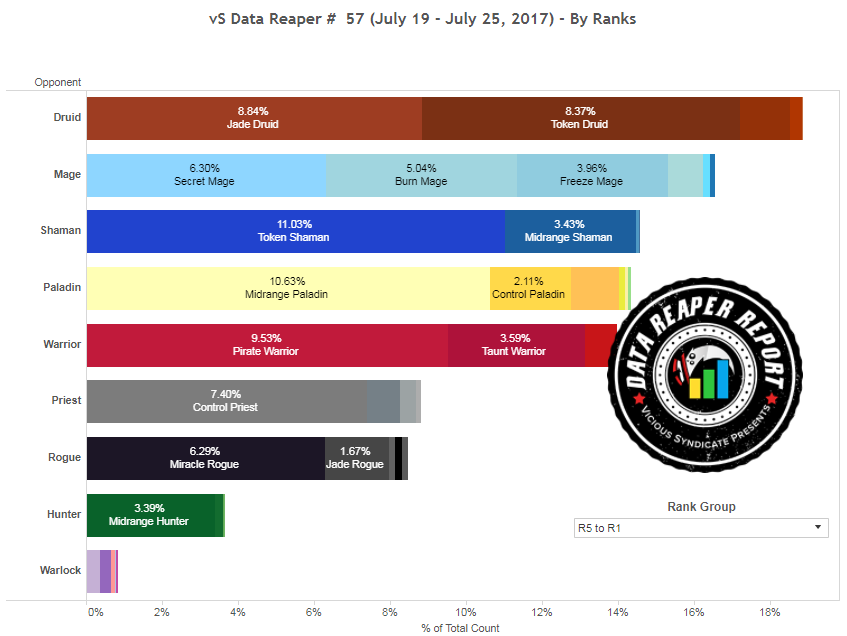
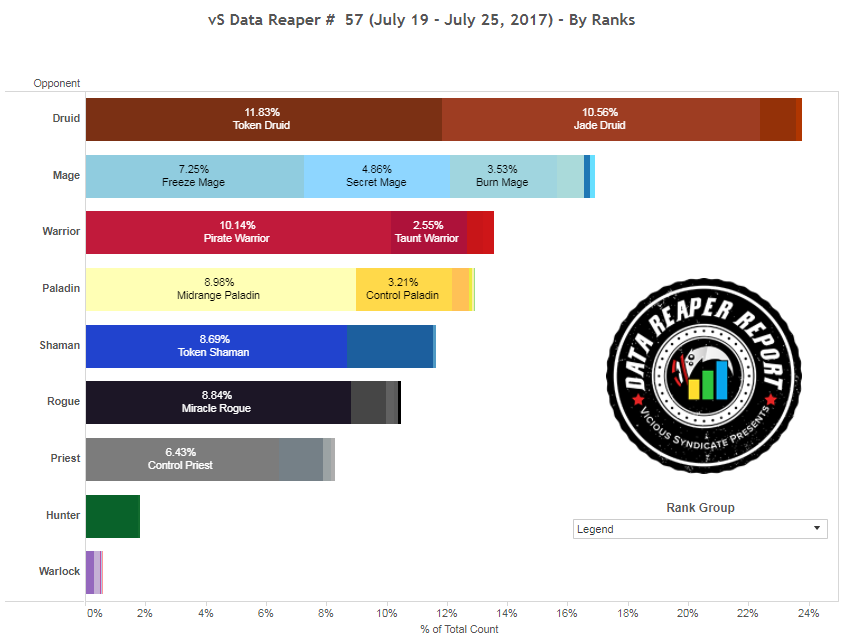 Class Frequency by Day
Class Frequency by Day
Class Frequency by Week
Class Frequency Discussion
As we are reaching the final few weeks of Un’Goro, the meta is showing typical patterns of stagnation before the launch of the next expansion. The top two classes, Mage and Druid, are seeing a small rise in play. The most notable movement among these classes comes from Freeze Mage, which has seen a further rise in popularity at legend, as more players are seeing the merits to the archetype compared to Burn Mage.
Next in line are Shaman, Warrior and Paladin. Save for a small uptick of Pirate Warrior at lower levels, and a small rise in Midrange Paladins at legend, not much has changed. Shaman is less popular at legend, where Freeze Mages run rampant, while the opposite is true for Warrior due to Pirate Warrior’s great matchup against Miracle Rogue, which is abundant at higher levels of play.
Rogue is on a decline mostly attributed to Jade Rogue beginning to fade away after the balance change initially sparked up interest in the archetype. It is notable, however, that Miracle Rogue has also declined at legend ranks. With the popularity of Pirate Warrior and Freeze Mage at the highest levels of play, this comes as no surprise. Miracle Rogue tends to spike in popularity when the meta is sent into disarray and people are more willing to experiment, but when things stabilize, there is less room for Miracle Rogue to punish unrefined decks.
While Priest is more popular than Rogue at lower skill levels, it has settled into a bottom three spot at legend ranks. The class can definitely see success in the right environment, but it is much more inconsistent than the top 6 classes in terms of build choices. It tends to go all over the place when it comes to finding its win condition. Hunter continues to linger in mediocrity, while Gul’dan has flat-lined long ago.

vS Power Rankings Discussion
As we’re reaching the end of the month, the meta becomes more competitive. As a result, it’s becoming more difficult for archetypes to maintain dominating win rates against the field, especially at legend ranks where the power ranking table once again appears to be quite “flat”. We can observe small declines in the scores of Pirate Warrior, Midrange Paladin and Secret Mage. The deck that has suffered the most this week is Token Shaman, which has completely crashed and burnt at legend and its win rate has dropped even below the 50% mark. While the deck has an extremely strong matchup spread, it has one crippling counter, which is Freeze Mage. This matchup is so lopsided that even the smallest increases in this archetype can significantly drop Token Shaman’s performance, and this is what happened this week. Outside of legend, Token Shaman is still very strong, but once you reach Freeze Mage’s turf, you’re likely going to have a much more difficult time picking up wins with the deck.
Freeze Mage seems to have recovered from the balance change, and while Jade Druid is preventing it from reaching its previous heights in terms of win rate, it is still very strong against the field. Burn Mage, in contrast, is continuing to collapse in its win rate. There are likely two reasons for this. The first is that Burn Mage is simply inferior against the field, and has been for a long time according to our metrics. Hybrid Freeze Mage does what Burn Mage does, better and more consistently. The second is that the best players, who are educated about the meta, are more likely to abandon the archetype in favor of Freeze (which lines up with these archetypes’ popularity at legend and outside of legend). This results in the performance of Burn Mage continuing to get worse as time goes on, a phenomenon we have observed in the past in other archetypes that were made redundant as a result of a competing archetype.
A meta staple that has jumped in its win rate is Token Druid. This archetype performs better at legend than outside of it due to the increasing popularity of Midrange Paladin and Pirate Warrior. It has to be said: the deck wouldn’t be nearly as good without the crab package, which are tech choices that carry very low risk for the deck but provide a very high reward. Crabs are just crippling swing cards against their targeted tribes and provide a design band aid against decks that would probably be too powerful without their presence.
Jade Druid has stepped in the shoes of Crystal Rogue in more ways than one. It is being played more than it should considering its unimpressive win rate against the field. The explanation is quite simple: most of the popular meta decks just straight up beat it. What makes it different than Crystal Rogue is its performance at legend. Crystal Rogue, at least, displayed a high skill cap and improved win rate at legend throughout most of the Un’Goro timeline. Jade Druid is showing no signs of that, and never has, even during MSG. Ramp Druid has seen a drop in its score, which isn’t too surprising since the meta has finished its small refinement stage after the balance change, but it is still performing better than Jade Druid at the top end of ladder.
Miracle Rogue’s win rate is still hovering near the 50% mark. Ironically, the deck actually performs worse at legend due to the increased presence of its biggest counters (Freeze Mage, Pirate Warrior). Jade Rogue is improving in its score, but it doesn’t seem like this improvement is nearly enough to make it competitive. Its win condition is significantly slower than Miracle Rogue’s, which worsens many of its matchups. The Jade mechanic naturally counters slower decks, but Miracle Rogue already counters control decks pretty well.
Priest builds are still quite messy, so Control Priest’s score is a testament to that. Within this diverse cluster, we don’t see a gem waiting to break out, so its power ranking score is quite indicative of the archetype’s struggles, save for some individual successes that are hard to replicate. The best Priest deck actually resides outside of this cluster. While Silence Priest does have quite a few counters in the current meta, and really struggles against Paladins and Shamans, its matchup against Jade Druid is so ridiculously one sided that it makes up for it. This single matchup pushes the deck into quite an impressive win rate despite its low play rate. If you’re running into a lot of Jade Druids, Silence Priest is an easy way to farm them. It’s almost unfair.
Control decks. They aren’t quite as good as they were predicted to be by many people after the balance change. Control Paladin is a fairly strong archetype that can certainly do well and is probably your best bet if you’re a fan of the suppression playstyle. Taunt Warrior is another choice, but is more limited and linear, and has a much more difficult time dealing with Jade Druids. Slower Shaman decks are also not doing well enough, with Midrange Shaman remaining lukewarm while Control Shaman is non-existent. Face is the place.
Class Analysis & Decklists
Druid | Hunter | Mage | Paladin | Priest | Rogue | Shaman | Warlock | Warrior
Ramp Druid is proving itself to be a sleeper deck. It has greatly benefitted from the post patch meta, and though its performance is trending down, it’s still a solid choice. While the deck is dismissed by some as a deck that relies on “high-rolling,” it sets itself up quite well to do so. Look to hard mulligan for ramp, and if ramp is present in the hand, keep key cards that combo with ramp, such as Barnes and Bright-Eyed Scout. Early removal should be kept in matchups against aggressive decks.
Note that unlike Jade Druid, the deck doesn’t run Feral Rages, and instead runs Moonglade Portals. It can be a great card to stabilize your health total while not falling behind on board, and can also be used to heal big minions in control matchups. Starfall has been seeing more play, and it helps a great deal against the board flooding decks that Ramp Druid generally struggles against.
Many would’ve predicted Jade Druid to run over the meta with the disappearance of Crystal Rogue. While the play rate of the deck has gone up significantly, its win rate doesn’t justify the deck’s popularity on ladder. Much of this is due to the fact that other counters to Jade Druid have risen, most notably Miracle Rogue.
Token Druid still holds a solid win rate across the board. Its play rate falls slightly behind Jade Druid at all ranks, but surpasses it at legend. It’s very strong against both Pirate Warrior and Midrange Paladin due to its ability to get on the board faster than any other deck as well as its debilitating crab tech.
Arcane Giants have consolidated their inclusion in Secret Mage. One of the deck’s early innovators, Surrender, reached top 20 legend utilizing a build slightly different than the one we’ve featured last week from Fenom, dropping the Sorcerer’s Apprentices for Volcanic Potion and Yogg-Saron, which provides the deck with stronger comeback mechanics. Arcane Giant is a card that was previously weak in the meta due to its ineffectiveness against Crystal Rogue. However, the card is extremely strong in slower matchups, such as Jade Druid. Arcane Giants also synergize with the archetype’s focus on tempo and general game plan of cost reduction and mana cheating, providing a big swing on the turn it is played, similarly to Crystal Runner.
Grothen continues to hold #1 legend with the Hybrid Freeze Mage deck that is becoming more and more popular. The success of the deck is testament to the high power level of cards such as Mana Wyrm and Firelands Portal. These cards, along with Medivh, enable the possibility of exerting board pressure, which the standard Freeze Mage list rarely does. Combined with the stalling tools at Freeze Mage’s disposal, which are extremely effective against aggressive decks, you have a winning formula. Antonidas remains a viable alternative to Medivh, which Ike has been running at the top legend ranks.
At the highest levels of play, Burn Mage is now the third most popular Mage deck. The Hybrid Freeze Mage just does most things better, rendering Burn Mage to be a bit obsolete. Although it still exists, unless it can reinvent itself, expect it to continue to fade away.
Exodia Mage is seeing a bit more play lately, likely due to the disappearance of Crystal Rogue. The deck’s popularity seems to be based more upon its interesting playstyle than a particularly good win rate. If fatigue decks ever become popular, which is seemingly unlikely thanks to Jade Idol, the archetype could gain more prominence as the inevitable death-deck.
- Mage Class Radar
- Laughing’s Freeze Mage
- GeorgeC’s Medivh Freeze Mage
- Grothen’s Hybrid Freeze Mage
- Surrender’s Giants Secret Mage
- Ant’s Secret Mage
- Muzzy’s Burn Mage
- GeorgeC’s Burn Mage
Every class in the game has undergone drastic changes since Un’Goro launched: whether it was the change in card usage within an archetype, or the creation of an entirely new archetype, the landscape has evolved. The notable exception is Warrior. Warrior has stuck with two archetypes that have barely changed at all from builds that were played days into the expansion.
Pirate Warrior hasn’t received any support in Un’Goro, and rightfully so. Its core pirate package is good enough, if not oppressive, barely held back by the introduction of some important tech choices such as Golakka Crawler and Gluttonous Ooze. The standard build remains the same, with Spellbreaker becoming more popular due to the popularity of Paladin and Spikeridged Steed as well as its ability to answer Doomsayers. The Bittertide Hydra build is very strong against Jade Druid, and is largely responsible for this specific matchup slightly tilting towards the Warrior after being locked in a 50/50 stalemate for a long time.
Taunt Warrior remains very one-dimensional. It does well against the board flooding token decks, but crumbles under the weight of Jade Druid and Midrange Paladin, and even its matchup against slower Mage decks relies on specific armor tech to become favorable.
For other Warrior archetypes to appear in significant numbers, it seems that support is required in new cards. Can Control Warrior and Tempo Warrior rise from the ashes? That new mini Death’s Bite could definitely help.
- Warrior Class Radar
- Standard Pirate Warrior
- Xzirez’ Pirate Warrior
- Eloise’s Taunt Warrior
- RayC’s Taunt Warrior
- Fibonacci’s Control Warrior
Midrange Paladin has truly separated itself from the pack and is by far the most played archetype in the class, while also boasting one of the highest win rates in the game. Hoej won an open cup last weekend with a slight modification to his original build, most notably swapping Deathwing for Onyxia, which is an option we’ve discussed in previous reports. Other players, such as Kolento, are having success on ladder with builds resembling Hoej’s list with some modifications. Ragnaros the Lightlord can be added as a tech card against Mages that also acts as a threat. Aldor Peacekeeper is another potential reactive card that can be included to act as soft removal, and the number of Rallying Blades vs. Truesilver Champions continues to be tinkered with.
Control Paladin and Aggro Paladin have more modest representations, with the latter barely seeing play at the top level. Control Paladin is a strong deck in aggressive matchups, but struggles to deal with the anti-control trifecta of Midrange Paladin, Miracle Rogue and Jade Druid. Aggro Paladin has a similar matchup spread to Midrange, but is more vulnerable due to its tendency of running out of resources. The one saving grace for this archetype that may help it see an uptick in play is its positive matchup against Midrange Paladin.
- Paladin Class Radar
- Sempok’s Midrange “UK” Paladin
- Hoej’s Midrange Murloc Paladin
- Ender’s Aggro Murloc Paladin
- SkyWalker’s Aggro Murloc Paladin
- Thijs’ Control Paladin
- Underscore’s Control Paladin
Token Shaman remains relatively unchanged, although there are cards that sometimes appear in the deck, such as Sea Giant. In light of Jade Spirit’s new Elemental tag, there is an option to run an Elemental package in order to provide the build with more longevity against control decks, as exhibited in Eloise’s build. All in all, the deck remains an excellent choice to ladder with. Barring Taunt Warrior and Freeze Mage, the latter being its biggest counter at the highest levels of play, the deck has neutral to good matchups across the board.
Midrange Shaman has seen a rise in play as a result of Crystal Rogue’s disappearance, but it is still far less popular than Token Shaman. With the Jade Spirit change, the Jade-Elemental hybrid builds have become the most common. Tempest reached #23 legend with a Midrange Shaman list that swaps Things from Below for Jade Chieftains. Chieftains provide more value at the cost of being much slower, a nod to control matchups. Spirit Echo has great synergy with the Jade package and it is often included in Midrange Shaman builds as a single copy for this reason.
Rogue’s representation at legend has taken a bit of a dip, while it remains steady across the lower ranks. With Pirate Warrior and the Mage class still quite popular, life for Rogues can be tough, but Miracle Rogue’s fantastic matchup against Jade Druid is one of the primary reasons for the archetype’s ability to succeed.
Some dedicated Rogue specialists have been doing well with their own variations of Miracle Rogue. RastaFish hit #1 legend with a very lean build that’s geared to beat aggressive decks such as Token Druid and Token Shaman. Favoring Shaku over Sherazin, running one Shiv instead of a Mimic Pod, while excluding Questing Adventurers, are all testaments to that.
At Dreamhack Atlanta, only 2 of the top 16 favored Miracle Rogue as an option to counter control decks in the Last Hero standing format. Rogue is usually a very strong class in tournaments, but it performed very poorly in this event, likely due to the popularity of Mage and aggressive decks in line ups.
Not much development has been seen in Jade Rogue, which continues to be a fun, but far less popular and successful alternative to Miracle Rogue, with its small representation staying rather similar across all ranks.
- Rogue Class Radar
- Villain’s Miracle Rogue
- RastaFish’s Miracle Rogue
- Weghuz’ Miracle Jade Rogue
- Purple’s N’Zoth Jade Rogue
Priest doesn’t make any giant leaps this week, as mostly everyone who still wants to be playing this class is toying with random Control builds. The pure control and the dragon variants have become the norm for any Priest you will be seeing on ladder.
There was continued experimentation with Control Priest as Weghuz and Zetalot both took varying packages to high legend this past week. Weghuz’s build is based around Medivh and high cost spells to out-value your opponent. Elise remains a staple, so the name of the game is just surviving until the value overload cripples your opponent. Dragon Priest operates in a very similar way, but exchanges the Medivh package for the more nimble Operative package.
Zetalot’s Control Priest is very different, and contains a plethora of cards that are anti-aggressive, looking to clear the board in multiple ways. Even Shadow Word: Horror makes an appearance, a nod to Sequinox’ Horror Priest which featured the same attack manipulation combo tools.
Outside of all the experimentation, Priest players are mostly just waiting in the wings, praying to the almighty Brode for that one special card that will set Priest apart from the rest of the crowd. Shadow Visions and Lyra the Sunshard have been incredible additions in Un’Goro, and time will tell whether the class will gain the tools required to potentially sit closer to the top of the meta.
- Priest Class Radar
- IAmTheKing’s Medivh Control Priest
- Weghuz’ Medivh Control Priest
- MagicGeek’s Inner Fire Control Priest
- Zetalot’s Pint Horror Control Priest
- Meati’s Dragon Priest
- Standard Silence Priest
Hunter is played over five times as often at ranks 15-11 compared to legend rank. The extreme difference in play rate comes from a combination of factors, including being an easy class to play, having very little counter queue potential at legend, and the biggest reason, which is being a weak class. Hunter struggles to match up with the stronger early game of other classes, and by the time the later turns roll around, it often finds itself either out of cards or simply dead. The general weakness of the class is what led to Hunter’s absence in the Dreamhack Atlanta top 16, and is the biggest factor for its exceedingly low representation at legend. Don’t expect Hunter to do anything relevant until the new expansion is released.
- Hunter Class Radar
- Freakeh’s Midrange Hunter
- NickChipper’s Hybrid Midrange Hunter
- Abar’s Secret Face Hunter
Just wait a little bit more, Gul’dan! You’re going to get exciting new cards that will strike fear across the Innkeeper’s Tavern. Your new legendary has already been revealed, and it looks like another cog in the elaborate machine that is Discard Warlock. Yes, the Discard mechanic is getting more support, Gul’dan!
Gul’dan?
Hey, why are you running away crying?
- Warlock Class Radar
- Janos’ Zoo Warlock
- Doomguard Murloc Warlock
- SkyWalker’s Sea Giant Murloc Warlock
- Firebat’s Doom Handlock
Let’s do something different this week. Rather than earmark a specific deck, we discuss the meta cycle in order to better understand what makes a deck good at any given time. Hopefully, the following write up provides insight to players deeply interested in the Un’Goro meta’s behavior.
The most inherently powerful decks in the game are Midrange Paladin and Pirate Warrior. They are strong because their tribal synergy’s power level is high and they will severely punish any opponent that doesn’t immediately deny their ability to snowball. In a neutral meta that doesn’t target anything specific, their win rates will naturally float up to the top.
The primary counters to these decks are board-flooding aggressive decks. They are able to get on the board early and deny the tribal synergy by beating murlocs and pirates off the board. Token Druid is further aided by its crab package, often swinging the game into an unrecoverable state for these archetypes. Token Shaman’s Devolve cripples tribal synergy in a different way (AOE rather than single target), but the result is the same.
Freeze Mage is the primary counter to board-flooding aggressive decks since they rely on going wide in order to finish the game through a board centric finisher (Savage Roar or Bloodlust). Freeze effects and Ice Block heavily punish this game plan and flood decks’ lack of defensive tools means that all the Freeze Mage has to do to win the game is stay alive and run them out of resources. This is more difficult to do against the tribal synergy decks that can execute vertical pressure through weapon damage and buffs, but Freeze Mage does not suffer in their presence either. These matchups are a wash.
Since Freeze Mage’s defensive tools are consistent enough to deal with aggressive decks (a lot of this is thanks to Arcanologist), its primary counter is healing/armor gain, which makes decks like Jade Druid and Control Priest enticing options even though their performance against the field is weak overall. This is probably the best explanation why these archetypes remain popular and show up often in tournament line ups as well. They are very important in stopping Freeze Mage from going out of control.
What counters Jade Druid and Control Priest? Quite a few decks, but the most notable ones are Secret Mage and Miracle Rogue. It’s not a coincidence that both of these archetypes currently utilize Arcane Giants. Even though they are quite different at their core gameplay, both rely on mana cheating mechanics in order to create big board swings. These board swings are crippling to slow decks that are littered with reactive cards, or cards that fuel a slow win condition that takes time to ramp up.
And what counters mana cheating tempo decks that abuse these mechanics in the midgame? Tribal decks that exert immense pressure before the mana cheating becomes relevant. This brings us back to Pirate Warrior and Midrange Paladin. The first heavily targets Miracle Rogue while the latter is a hard counter to Secret Mage.
Of course, the meta has more interactions than what we’ve discussed here in order to create the current fabric of strategies (Midrange Paladin has an important interaction with Jade Druid, and Miracle Rogue is heavily impacted by the Mage class), but this is the crux of it when it comes to the most popular archetypes, and the meta will very often shift from one grouping to the next in the following fashion.
Learning to identify these patterns in real time will likely help you choose the best deck to climb, and this is particularly important at the top end of ladder play, where most players are very quick to adapt and switch decks according to what they’re facing.
Our Data Reaper Project, including the Data Reaper Live (Beta) has 2,200 active contributors. Without them, this project would not be possible, so we’d like to thank all of our contributors for their help.

Preparing our weekly article requires a significant amount of time and effort from many individuals. We would like to wholeheartedly thank our current Patreons, whose generous donations help us fund computing and server costs.
Tier 3+ Patrons
Special thanks to Leo G, Chungfr, Kognar, Zach D, Aaron B, Jed M, Caleb G, Drew M, Alan J, lalasong, Eric L, Steve F, and Batz for supporting us for the month of July.
A HUGE thank you to our Tier 5 Patron(s): ByteCookie, Haya A, and Curt S!
Contributors
Here are all the people that participated in bringing you this edition of the vS Data Reaper Report:
































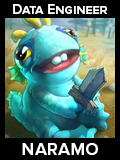

Not a single comment about StanCifka’s Top10 Legend Control Warlock? I understand it doesn’t make Gul’dan great, but it is also no easy feat.
Very insightful write up about the meta.
Great job as always!
I notice there’s no Warlock expert. I never thought the king of zoo would end up like this…